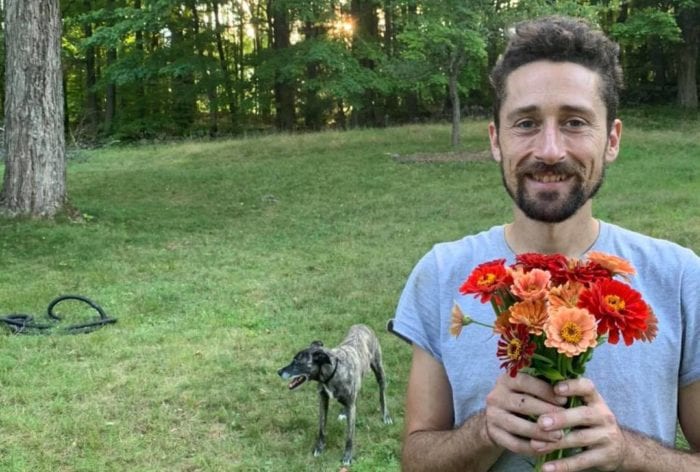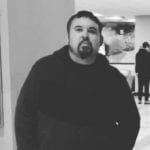
Matt Lorenz on new album, rapid cinematics, and plans for winter
The art of the one-man band can be an incredible thing to witness. Some critics say it might be kitschy or they’ll put on their purist cap while voicing their confusion, but it’s still pretty cool to see what a musician can pull off with a guitar, kick drum and a bunch of other sonic gadgets by themselves. Dare I say it, some of these acts sound better than your typical duo, trio and/or quartet. For the past few years, Amherst resident Matt Lorenz has been doing this kind of thing as The Suitcase Junket. It’s a unique spin on Americana and his sixth album, The End Is New, is being released via Renew Records on November 20.
We had a talk ahead of the album’s release about how he came up with the vision for his current project, making the album through opposite coasts, striving for that classic connection and feedback through music in the era of COVID-19 and plans for the winter.
As a one-man band, you are able to harness a fuzzy blues sound. What inspired you to come up with the vision for this and how did you go about getting the gear to make The Suitcase Junket a reality?
It was a while ago now and there were a few things going on. I was playing in a band where we were starting to split up the drumming and I was already starting to play with my feet a little bit. Then I was carrying around this homemade cajón for a while that eventually got played to smithereens, which made me switch to old accordion cases and suitcases because they have the handles built in there and they’re easier to carry. I started retro fitting these little can drum ideas and I’ve always been a bit of a tinkerer, I like getting a familiar sound out of unconventional instruments or what have you. I think some of that came from being really into Tom Waits at the time and sort of digging this idea that we’re all basically stealing from each other but what sets us apart is our tone, sound, and how we approach what we get.
I started building these foot drums and the guitar that is sort of responsible for the rest of the band, there’s a lot of restriction to it with it being one of those Sears mail order things. It’s bottom of the line, the action on it is way too high and you can’t do that much on it but that sort of restriction informs a lot of the songwriting. Before that, I was pretty chordy and coming out of the jazz world from college so this really simplified a lot of ideas for me. The Suitcase Junket was born out of this guitar and out of this desire to make as much sound as I could as one person without delving into loops or too many effects. There’s a little bit of a pull against technology involved in the original concept which is still there but I have started to look into the world of pedals, nothing too crazy yet though.
It’s cool that you found beauty in simplicity to make it as the base of the project. Back on October 2, you released a music video for the track “Black Holes and Overdoses” off of The End Is New. The video has three TVs in an attic with you wearing a motorcycle helmet and a jumpsuit with it cinematically being very fast paced. How did you and director Joshua Kilcoyne come up with this motif for the video?
It was an interesting kind of process we had, we’ve worked together on stuff in the past and he recently relocated out to L.A. so obviously we wouldn’t be able to be in the same room. We had the idea of making a lyric-based video and I was sort of moving my music studio space from inside my house out into a barn area. I had a lot of boxes open and I found a little VHS camcorder that I’ve had since I was a kid which was still working and I was going for that sort of look. He was interested in that as well so we got our hands on some old TVs and it got more and more complex as the more we got into it. I sent him a small fragment of an idea as the character being a tin-foil-hat kind of buffoon up in his attic trying to separate himself from the rest of the world.
He would come back with a whole other string of thoughts and directions so there was this boomerang kind of thing or like a game of toss where I would have an idea and he would come back with all of these things. We ordered a bunch of lighting stuff online so he had a bunch of stuff shipped to me. Basically I would have my day, we would have dinner and after that from 11pm to 3am I would go up and do all of the video stuff while seeing what the room looks like with moving the lights to different spots. It got very, very specific as we went on and there’s hundreds of hours of footage that we wound up getting that had to be trimmed down, it was a lot. It was a blast, he’s an interesting artist and you can tell how much went into it when you watch it, it’s basically two videos in one and one of them is going triple time.
You summed it up perfectly, there’s two videos in one with you going through the TV and behind it is you acting out in front of the TV in front of the camera that is relaying the footage to the front. It’s kind of like a vertigo effect.
Yeah.
When it came to making The End Is New, are there any things you did differently this time around than you did with your previous releases? Either with vision, tone or with different production techniques?
The plan was definitely to bring more people on board in the process but then after the initial basic tracking that happened in February, the next few studio dates were when we were going to start bringing people in and that was in March. That got cancelled and Steve Berlin from Los Lobos, who produced the album, got stuck on the West Coast. In terms of sound, we did try branching out even more and Steve is kind of famous for that, we would take a good hour to get the guitar sound we were looking for. He would radio in and try to give input via phone or text and we ended up getting more musicians on the album but it wasn’t the original vision of getting people in the studio and having that camaraderie. Approach-wise, it wound up being just having to deal with this crazy situation of releasing a record with a producer who’s on the opposite coast.
I wasn’t trying to do anything totally out of the ordinary for this one but as you make each record you grow and your sensibilities change. Obviously your skill set changes so you end up making a lot of different choices but we weren’t trying to make a huge turn, we just wanted to dig deeper into the sound and make them a little bit more cinematic.
Adapting to working with Steve while he’s on the West Coast guiding you through the process must have been a crazy time. You’ve done both some virtual events and socially distanced live shows this year. What are your feelings on these types of gigs in this “new normal” we’re all in?
It all feels really weird, every single part of it. I did a couple virtual shows early on and they were good but very disorienting because you’re in your space after you’re done playing a song and that’s it. There’s no feedback, people will leave comments and that sort of thing but it’s not the same thing as being in a room or on a festival stage where you get that real feedback. I did a couple of live shows and it felt great, it was closer to that magical thing that’s one of the reasons we perform but with everyone seated and spaced it was a lot more subdued than what I’m used to. With that being said, it felt great to be connecting with people again and to be giving back because that feels important especially during a time like this.
It’s fraught in so many different ways, it felt good to connect with people but at the same time I was a little bit terrified because I don’t want to be responsible for anyone getting sick. People have been really, really good about it but it’s weird. I’ve been playing live shows for over 10 years and for the past five I’ve been doing roughly between 150 to 200 shows a year, so now it’s like I’m getting a compiled vacation that I didn’t ask for. It feels odd and there’s a part of me that’s kind of missing.
I can totally see that, especially with how everything is going and you really can’t tour with there being so many limited opportunities to play live music and those are becoming even less with the winter coming. You kind of alluded to it, but after The End Is New comes out what are your plans for the coming months? Do you plan on livestreaming on a regular basis? Do you have another record in the works?
We’ll see, during normal years I tend to stay off the road during the winter anyway. I’ll work on new material and we have a few sugar maples in the backyard so in February and March we do a little maple sugaring which has been in the family for a while.
That’s awesome.
My partner and I just had a kid so there’s going to be a lot of hanging out with the boy and hopefully I’ll have a home studio put together soon. There may be some new material after this, certainly with writing. I don’t know if I’ll get to record this winter, I tend to move a little bit slow with that but I always try to keep productive and keep my eye on the next thing. I’ll be planning to tour the new album in the spring but who even knows what spring is anymore?
Rob Duguay is an arts & entertainment journalist based in Providence, RI who is originally from Shelton, CT. Outside of DigBoston, he also writes for The Providence Journal, The Connecticut Examiner, The Newport Daily News, Worcester Magazine, New Noise Magazine, Northern Transmissions and numerous other publications. While covering mostly music, he has also written about film, TV, comedy, theatre, visual art, food, drink, sports and cannabis.

